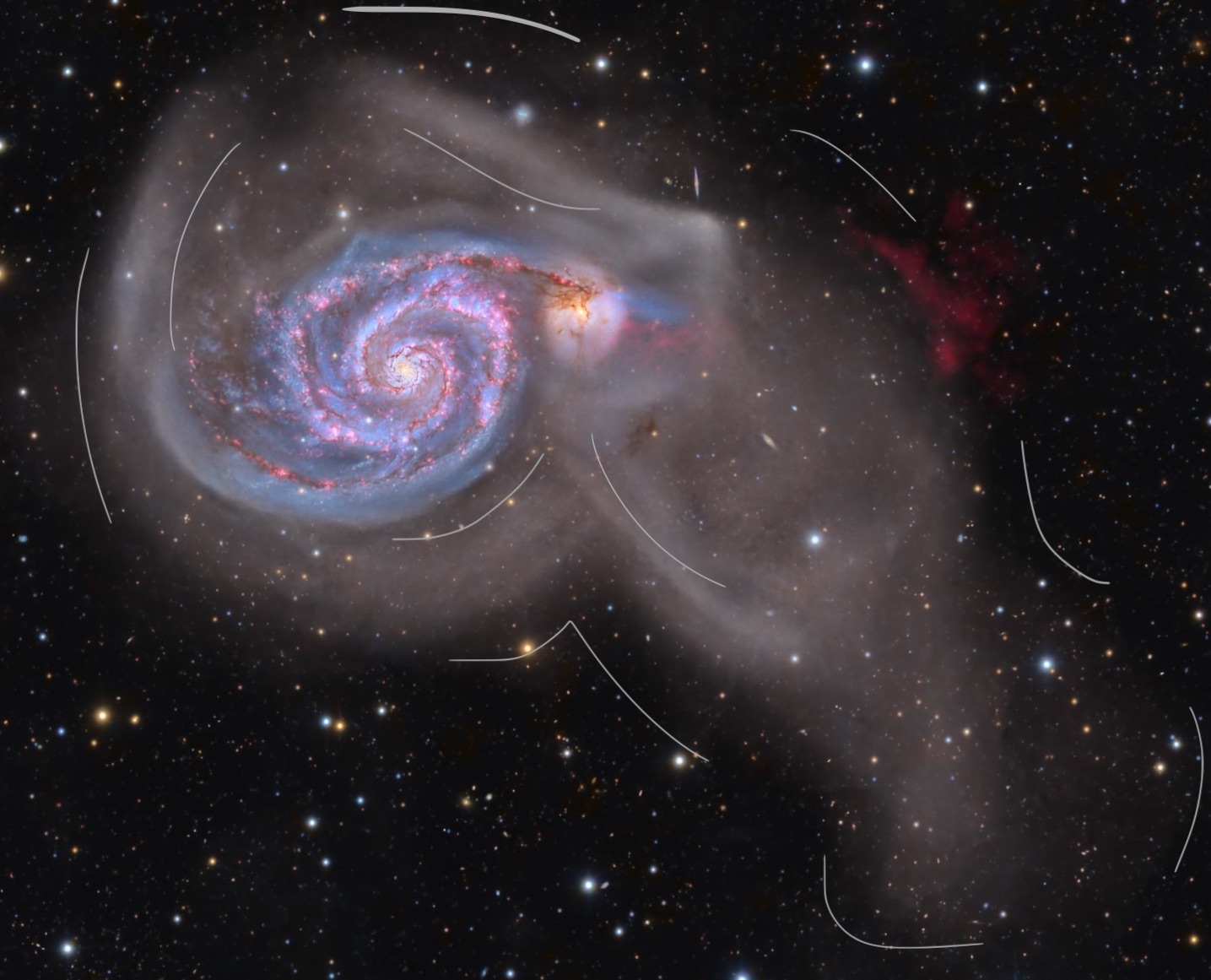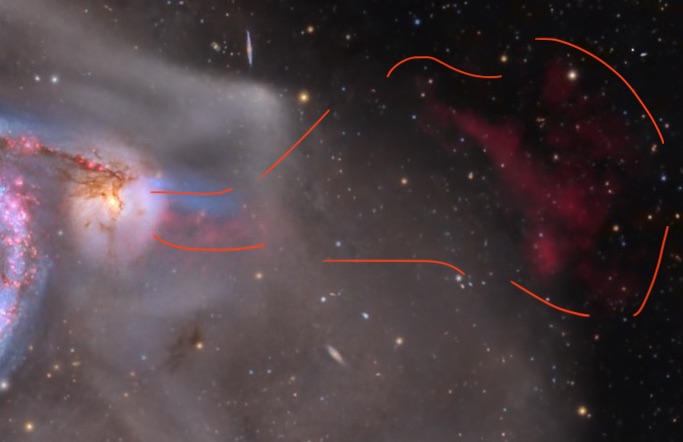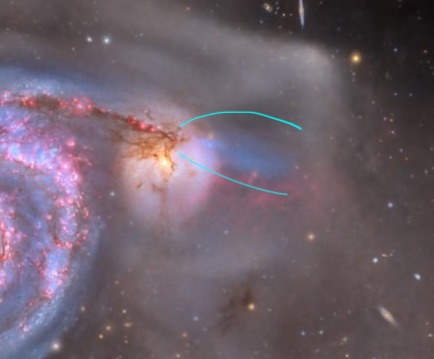Our latest collab and my first contribution to a NASA APOD!
The Whirlpool galaxy, also known as Messier 51, is a galaxy located in the constellation Canes Venatici. It lies at a distance of roughly 23 million lightyears and spans some 80.000 ly in diameter. M51 is a pretty popular target amongst astrophotographers as it has some very distinctive spiral arms which were first discovered by William Parson in 1845, also making it the first object where spiral arms were detected.
Another unique attribute to this galaxy is the tidal stream which shows even at low integration times. The full extent of the tidal stream on the other hand is rarely shown, which is also part of the reason why we started this project, in the end, we were able to reveal even the faintest parts of it. These streams are a result of the tidal interaction between M51a (the big one) and M51b (the small one). So in fact M51 can be considered as two galaxies rather than one.
As this tidal interaction makes M51 so interesting, the galaxies have been studied excessively to better understand what’s happening between two merging galaxies. However, it wasn’t until 2018 that A. Watkins et al. discovered a large ionised gas cloud north of the galaxy system, which is one of the things we focused on for this collaboration. You can spot this recently discovered ionised gas cloud in our image on the right hand side - it was revealed using 118h 39mn of integration time in the Ha wavelength and was quite the challenge to reveal, but more on that later. In order to reveal both the entirety of the tidal streams and the Ha cliff formation, we knew we had to gather lots of data. After our big project on the galaxy pair M81/82, our team wanted to keep the cooperation going - together we decided that M51 will be our next target. As some people weren’t able to contribute this time, new ones joined in and our group for M51 now consists of 16 people: 1 Editor and 15 photographers.
As we want to keep this going in the long term, we also decided to get a team name - The Deep sky collective. By mid-July, after rejecting bad frames, we were left with 254h 51m 30 s total (or ~10.6 days); this also marks the longest integration time ever on M51 from any group of amateurs
Before getting into any details in the picture, I want to thank everybody who contributed to this project. It was a pleasure working together with everybody!
- Carl Björk - @Palmito
- Thomas Bähnck - www.newhorizonobs.de
- Sebastian Donoso - @georgian82
- Jake Gentillon - @jake_g
- Antoine and Dalia Grelin - www.galactic-hunter.com
- Stephen Guberski - @Stephen Guberski
- Richard Hall - @Richard
- Tino Heuberger - @RononDex
- Jason Jacks - @jmdl101
- Paul Kent - @pkastronomy (Instagram)
- Brian Meyers - @Brian M.
- William Ostling - @William Ostling
- Nicolas Puig - @Nicolas PUIG
- Tim Schaeffer - @Tim Schaeffer
- Felix Schöfbänker - @SomeAstroStuff
- Mikhail Vasilev - @Mikhail Vasilev
Special thanks to:
- Carl, who stacked all of our nearly 5000 files, which took over 3TB of space and several weeks of processing, a lot of trial and failure, and a lot of patience. Big thanks to his immense commitment to this project, it wouldn’t be possible without him.
- William, our editor and instructor on anything processing related and who also proof-read this text. Also big thanks to him for checking every possibility with Carl to get our stacks to work, and for the wonderful and time-consuming edit you see here.
- Paul, Antoine and Dalia, who gave us their excellent Bortle 2/3 data that was used for MSGR
Interesting features in our image
First of all of course the entirety of the tidal stream.
Tidal streams are diffuse, elongated structures of stars, gas, and dust, often extending beyond the boundaries of galaxies. As M51a and M51b are currently engaged in a violent gravitational interaction, the smaller galaxy M51b (or NGC 5195) experiences tidal forces that disrupt its shape and provoke the formation of new stars. Conversely, NGC 5195 also influences M51, leading to the formation of spiral arms, making this galaxy pair so unique. Furthermore, these tidal streams allow researchers to reconstruct the two galaxies’ orbital history as well as trace past movements of diverse stars or gas in the galaxy, allowing for a more exact understanding of interactions between galaxies. In order to get this entire stream, long integration times and dark skies are required. In the end, we had 68h 57mn of Luminance which ensured nice details and a high SNR view at the stream.

The Hydrogen alpha cliff formation.
The Ha cliff formation is a remarkable but rarely imaged feature found within the Whirlpool Galaxy. This H-alpha emission, emanating from regions of intense star formation, is a crucial indicator of the presence of young, massive stars that ionise the surrounding gas, causing it to emit this distinctive wavelength of ionised Hydrogen. To be more precise, this cliff formation is a result of the interaction between the two galaxies; the violent gravitational forces at play tug at the gas clouds, which in turn can cause them to become unstable and collapse under their own weight - this collapse triggers the formation of young, energetic stars which particularly radiate in short wavelengths (such as UV) which in turn causes the surrounding hydrogen gas to ionise resulting in the distinctive Ha emission.
Capturing this region proved to be an immense challenge. In the first stack, we had about 80h of data with relatively short exposures ranging from 300” to 600” - we quickly realised that although the integration time was high, the cliffs were barely visible and couldn’t properly be extracted in post-processing. After some discussions, we realised that the signal is so weak that the noise floor of the sensors overpowers it. In our last attempt, we shot nearly another 40h of long exposure subs ranging from 900”-1800” to get the signal to show up, which it indeed did in the end. So for anyone who wants to try this in the future, take exposures as long as your tracking allows you to; the longer the sub-exposure the better.

Blue stellar stream
Similar to M82’s blue stellar stream, M51 also has one that can be found to the north of the galaxy (right hand side of the picture and) but is rarely noticed. With nearly 20h of integration in the blue channel, we were able to get the stream to show up in great detail. As for the cigar galaxy, the exact origin of this stream is yet to be exactly determined. The two leading explanations are that it’s either an interaction remnant or a shocked starburst stream, though most likely it is a secondary result of a galactic low-velocity shock caused by the interaction between M51a and M51b. The resulting shock heats and compresses the gas to optimal star-forming conditions, giving the stream its signature blue colour.

Many small galaxies and galaxy clusters.
Further, there are many many small galaxies and galaxy clusters that can be found in the background of the image!
End Note
For any further questions about the project, feel free to leave a comment on the original Astrobin post https://www.astrobin.com/7hwtz0/
For a more technical overview of the editing, please refer to Will’s website: https://theastroenthusiast.com/m51-processing/
If you want to see our image in greater detail, feel free to go to Carl’s website, where the image is uploaded in full resolution, enabling you to explore the picture by yourself and being able to zoom in on every tiny detail! Link to his website: https://elveteek.ch/m51-dsc
Finally, Antoine and Dalia made a video talking about this project and you can check it out here: https://www.youtube.com/watch?v=zkES2ltGSoc
Integration overview
Here you find a list of integration contribution from all 15 photographers

We hope that you enjoy this image!
Text written by Tim @Tim Schaeffer, organiser and co-ordinator of the project and fact checked & proofread by William @William Ostling.
